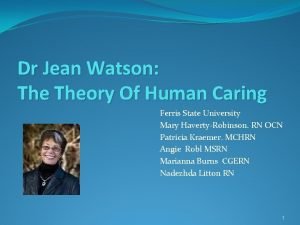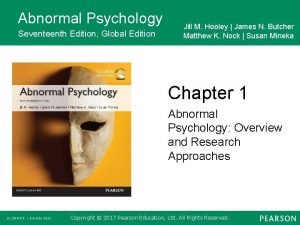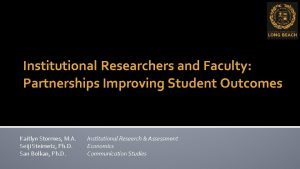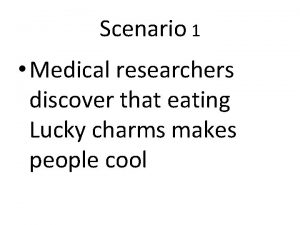Caring Research for a Caring Place Researchers in
















- Slides: 16

Caring Research for a Caring Place Researchers in Care Homes: Nuisance or Necessity? Dr Julie Watson University of Edinburgh ECRED/Nursing Studies 1

Overview of next 10 minutes • Examples of two care home research projects – What the projects were about – Key findings • Consider which aspects were a nuisance and which a necessity 2

Example 1 (Image purchased from i. Stock with permission to use) Aim: To understand how care staff and people with advanced dementia relate to each other in a care home What I did. . • 10 months observing and working alongside staff in one care home • 24 interviews with staff • 3 group discussions with staff 3

Key findings • People with advanced dementia are actively engaged in relationships until the end of life. • The importance of non-verbal communication and interaction. • Hands-on bodily care of people with advanced dementia is complex and key to relationships. • Feelings of residents and staff are interconnected 4

Nuisance? Necessity? 5

Nuisance - to residents and families • • This is their home Capacity issues Taking staff away from residents Intrusive – ethical issues – invasion of privacy 6

Nuisance – to the staff • Staff feeling watched • Trust – worries about researcher seeing things that are wrong • Taking up staff’s time when busy • No benefit to the care home in the short term 7

Necessity • People with advanced dementia can be seen as ‘already dead’ • Expertise in care homes we can learn from • Some care homes struggle - what works? • Evidence base of care home care and dementia care needs further developed - care homes are also work places and regulated care providers 8

Example 2 Aims • To explore student nurses’ attitudes towards care home nursing and their knowledge of, educational opportunities within the care home setting. What we did… • Focus groups with 36 student nurses at University of Edinburgh • Making a short film about care home nursing with students 9

Key Findings • Student nurses: – don’t consider care home nursing a good career – influenced by negative media stories – think they will ‘lose clinical skills’ AND ‘have too much responsibility – need to know more about and hear positive stories about care home nursing 10

Nuisance? Necessity? 11

Nuisance • Asking students to give of their time for a focus group (with lunch!) • Asking students to volunteer time to make a film • Asking care home nurses to volunteer time to be interviewed and filmed 12

Necessity • There is a recruitment and retention crisis in care home nursing • Most student nurses training in acute care • 3 times as many care home beds as acute NHS • By 2040 care homes are projected to be the most common place of death (Bone et al 2017) 13

Summary and Conclusion • Described two examples of care home research • Illustrated the tension between research as a nuisance and a necessity Conclusion Despite the nuisances, research is a necessary part of the caring process that enables care homes to be caring places. 14

References • Bone, A. E. , Gomes, B. Etkind, et al (2017) What is the impact of population ageing on the future provision of end-of-life care? Population-based projections of place of death Palliative Medicine DO 1: 1077/0269216317734435 https • Watson, J. (2016) Developing the Senses Framework to support relationship-centred care for people with advanced dementia until the end of life in care homes Dementia DOI: 10. 1177/1471301216682880 online • Watson, J (2016) Face to Face: Relating to people with dementia until the end of life in care homes http: //hdl. handle. net/1842/16876 15

Julie. Watson@ed. ac. uk All images (except i. Stock purchase on slide 3) from Google Image labelled with permission for reuse 16
 Caring occasion/caring moment
Caring occasion/caring moment Place place value and period
Place place value and period A disturbance in a field that carries energy
A disturbance in a field that carries energy A disturbance that transfers energy from place to place.
A disturbance that transfers energy from place to place. Researchers who are studying a new shampoo formula
Researchers who are studying a new shampoo formula What is the cardinal rule of naturalistic observation
What is the cardinal rule of naturalistic observation Lisa attempts to retrieve her bottle
Lisa attempts to retrieve her bottle Analogue studies are used when researchers ____.
Analogue studies are used when researchers ____. Researchers
Researchers Difference between independent and one sample t test
Difference between independent and one sample t test Medical researchers discover that eating lucky charms
Medical researchers discover that eating lucky charms Patrick scrick
Patrick scrick Medical researchers followed 6272 swedish
Medical researchers followed 6272 swedish Iso 22301 utbildning
Iso 22301 utbildning Typiska drag för en novell
Typiska drag för en novell Tack för att ni lyssnade bild
Tack för att ni lyssnade bild Returpilarna
Returpilarna































